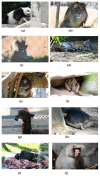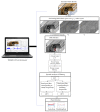A Pilot Study for Estimating the Cardiopulmonary Signals of Diverse Exotic Animals Using a Digital Camera
- PMID: 31835550
- PMCID: PMC6960731
- DOI: 10.3390/s19245445
A Pilot Study for Estimating the Cardiopulmonary Signals of Diverse Exotic Animals Using a Digital Camera
Abstract
Monitoring the cardiopulmonary signal of animals is a challenge for veterinarians in conditions when contact with a conscious animal is inconvenient, difficult, damaging, distressing or dangerous to personnel or the animal subject. In this pilot study, we demonstrate a computer vision-based system and use examples of exotic, untamed species to demonstrate this means to extract the cardiopulmonary signal. Subject animals included the following species: Giant panda (Ailuropoda melanoleuca), African lions (Panthera leo), Sumatran tiger (Panthera tigris sumatrae), koala (Phascolarctos cinereus), red kangaroo (Macropus rufus), alpaca (Vicugna pacos), little blue penguin (Eudyptula minor), Sumatran orangutan (Pongo abelii) and Hamadryas baboon (Papio hamadryas). The study was done without need for restriction, fixation, contact or disruption of the daily routine of the subjects. The pilot system extracts the signal from the abdominal-thoracic region, where cardiopulmonary activity is most likely to be visible using image sequences captured by a digital camera. The results show motion on the body surface of the subjects that is characteristic of cardiopulmonary activity and is likely to be useful to estimate physiological parameters (pulse rate and breathing rate) of animals without any physical contact. The results of the study suggest that a fully controlled study against conventional physiological monitoring equipment is ethically warranted, which may lead to a novel approach to non-contact physiological monitoring and remotely sensed health assessment of animals. The method shows promise for applications in veterinary practice, conservation and game management, animal welfare and zoological and behavioral studies.
Keywords: animal health; cardiopulmonary signal; conservation; denoising; non-contact; veterinary; vital signs; wavelet; wildlife.
Conflict of interest statement
The authors of this manuscript have no conflict of interest relevant to this work.
Figures





References
-
- Magnani D., Gatto M., Cafazzo S., Stelletta C., Morgante M., Costa L. Difference of surface body temperature in piglets due to the backtest and environmental condition. In: Köfer J., Schobesberger H., editors. Animal Hygiene and Sustainable Livestock Production, Proceedings of the XVth International Congress of the International Society for Animal Hygiene, Vienna, Austria, 3–7 July 2011. Tribun EU; Brno, Czech Republic: 2011. pp. 1029–1032.
MeSH terms
LinkOut - more resources
Full Text Sources

